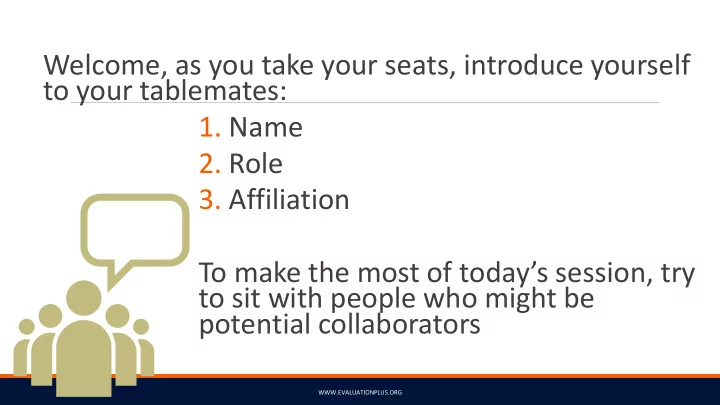

Welcome, as you take your seats, introduce yourself to your tablemates: 1. Name 2. Role 3. Affiliation To make the most of today’s session, try to sit with people who might be potential collaborators WWW.EVALUATIONPLUS.ORG
How to Eat an Elephant: Project Planning One Bite at a Time 5TH ANNUAL COMMUNITY ENGAGEMENT SPRING CONFERENCE LAURA PINSONEAULT, PHD EMILY CONNORS, MS
WWW.EVALUATIONPLUS.ORG
Adaptive planning tools & techniques Live in a world that is changing rapidly Offers better solutions for complex and complicated challenges ◦ Focus on results ◦ Uncovering assumptions ◦ Understanding context Supports action and shared ownership WWW.EVALUATIONPLUS.ORG
WWW.EVALUATIONPLUS.ORG
WWW.EVALUATIONPLUS.ORG
WWW.EVALUATIONPLUS.ORG
Common Ground Rules for Adaptive Planning Focus is on outcomes and actions, not on people and fault Everyone comes to the table (no excuses!) Everyone’s time is valuable Facilitator, facilitates (does not participate) ALL voices at the table are experts Revisit, revisit, revisit and revise WWW.EVALUATIONPLUS.ORG
Taking a Bite: The Premortem Builds understanding of beliefs and Puts learning at the Articulates failure and Mitigates risk assumptions that front end “lets it go” might be driving ineffective action WWW.EVALUATIONPLUS.ORG
Premortem Assumptions Facilitated Keep group small and focused Schedule for at least 10 minutes per person in the room Rough Scope of Work Start with the right question: ◦ What will go wrong? ◦ How will this end in disaster? WWW.EVALUATIONPLUS.ORG
Practice using adaptive planning tools: the project premortem 1. Review the project summary at your table. 2. Review the 6 hats storyboard 3. Individually, each write down all the reasons the project failed (5 mins) 4. As a table share the reasons (round robin) and have one member write them down on large post-it paper (5 mins) 5. As a table identify (*) the reasons of greatest concern / most likely to occur (5 mins) 6. As a table identify ideas for avoiding or minimizing those problems/concerns. (5 mins) WWW.EVALUATIONPLUS.ORG
Project Summary After many months of working on a large grant for a community engaged research project, your organization receives notice that the grant is funded. The project involves individuals from 3 nonprofits in three different states (NY, CA, and FL) and an academic researcher from a local university in FL. The focus of the research grant is on a peer-to-peer support program for older adults. All of the organizations implement the program and want to evaluate the outcomes of the program. The grant lays out high-level phases of the project, but little focus on how the team will work together to achieve the goals of the grant. Over the three years, each organization is responsible for recruiting older adults into the study (target goals and timing of those are set). Participants complete a pre/mid/post assessment over three years time and each organization is responsible for entering the data into a shared data system. The academic researcher and directors from each nonprofit are leaders on the project. A budget was developed. Each organization will receive funding to hire research assistants to help manage the program, minimal funds for general expenses, and some travel dollars for face to face visits (5 during the 3 years). Yearly progress reports are due to the funder and a responsibility of the academic researcher to submit. WWW.EVALUATIONPLUS.ORG
Practice using adaptive planning tools: the project premortem 1. Review the project summary at your table. 2. Review the 6 hats storyboard 3. Individually, each write down all the reasons the project failed (5 mins) 4. As a table share the reasons (round robin) and have one member write them down on large post-it paper (5 mins) 5. As a table identify (*) the reasons of greatest concern / most likely to occur (5 mins) 6. As a table identify ideas for avoiding or minimizing those problems/concerns. (5 mins) WWW.EVALUATIONPLUS.ORG
Reasons for failure identified? What was of greatest concern? What worked well/what did you Debrief like about the tool? What did you struggle with? WWW.EVALUATIONPLUS.ORG
Contact Information: Laura Pinsoneault, Evaluation Plus laura@evaluationplus.org Emily Connors, ProHealth Care Emily.Connors@phci.org WWW.EVALUATIONPLUS.ORG
Recommend
More recommend